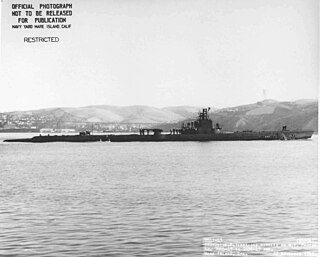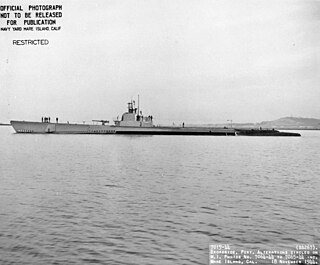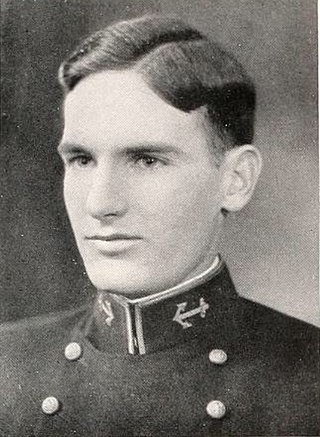
The Gato class of submarines were built for the United States Navy and launched in 1941–1943. Named after the lead ship of the class, USS Gato, they were the first mass-production U.S. submarine class of World War II.

USS Seawolf (SS-197), a Sargo-class submarine, was the second submarine of the United States Navy named for the seawolf.

USS Dace (SS-247), a Gato-class submarine, was the first submarine of the United States Navy to be named for any of several small North American fresh-water fishes of the carp family.

USS Darter (SS-227), a Gato-class submarine, was the first ship of the United States Navy to be named for the darter.
USS Gudgeon (SS-211) was the first American submarine to sink an enemy warship in World War II. She was the last of the long-range Tambor-class vessels commissioned for the United States Navy in the years before the country entered World War II. Gudgeon scored 14 confirmed kills, placing her 15th on the honor roll of American submarines. She was declared overdue, presumed lost with all hands, on 7 June 1944. Of the twelve Tambor-class submarines, only five survived the war.

USS Harder (SS-257), a Gato-class submarine, was the first ship of the United States Navy to be named for the Harder, a fish of the mullet family found off South Africa. One of the most famous submarines of World War II, she received the Presidential Unit Citation. Her commanding officer throughout her service, the resolute and resourceful Commander Samuel D. Dealey (1906–1944), "a submariner's submariner", was posthumously awarded the Medal of Honor, as well as four Navy Crosses during his lifetime.

USS Flier (SS-250) was a Gato-class submarine, was the only ship of the United States Navy to be named for the flier.

USS Gar (SS-206) was the first of the Gar subclass of the Tambor-class submarines to be commissioned for the United States Navy just prior to the country's 7 December 1941 entry into World War II. These submarines were a slightly improved version of preceding submarines of the Tambor class. While Gar survived the war, all of her sister ships — USS Grampus (SS-207), 'USS Grayback (SS-208), USS Grayling (SS-209), USS Grenadier (SS-210), and USS Gudgeon (SS-211) — were lost. She is the only ship of the United States Navy to be named for the gar, a fish of the family Lepisosteidae.

USS Pompon (SS/SSR-267), a Gato-class submarine, was a ship of the United States Navy named for the pompon, an American fish of the Anisot family.

USS Puffer (SS-268), a Gato-class submarine, was the first ship of the United States Navy to be named for the puffer.

USS Rasher (SS/SSR/AGSS/IXSS-269), a Gato-class submarine, was a ship of the United States Navy named for the rasher, or vermilion rockfish, a fish found along the California coast.

USS Ray (SS/SSR-271), a Gato-class submarine, was the first ship of the United States Navy to be named for the ray, a fish characterized by a flat body, large pectoral fins, and a whiplike tail.

USS Redfin (SS/SSR/AGSS-272), a Gato-class submarine, was a ship of the United States Navy named for the redfin, any of several North American fishes with reddish fins.

USS Guitarro (SS-363), a Gato-class submarine, was the first ship of the United States Navy to be named for the guitarro.

Samuel David Dealey was the commanding officer of a United States Navy submarine killed in action with his crew during World War II. Among American service members, he is among the most decorated for valor during war, receiving the Medal of Honor, the Navy Cross (4), the Army Distinguished Service Cross, and the Silver Star for his service on the submarine USS Harder (SS-257). He was the nephew of George B. Dealey, publisher of the Dallas News and for whom Dealey Plaza is named.

Lawson Paterson "Red" Ramage was a vice admiral in the United States Navy and a noted submarine commander during World War II. Ramage was decorated with the Medal of Honor and several other combat decorations during the war. He also served during the Korean War and the Vietnam War.

Manning Marius Kimmel was a United States Navy submarine officer in World War II and the son of Admiral Husband E. Kimmel. He served as both junior and executive officer on several submarines, and finally assumed command of USS Robalo as a lieutenant commander. Kimmel was reportedly killed when Robalo was sunk off the island of Palawan. However, the exact circumstances surrounding his death remain unclear.

Ralph Waldo Christie was an admiral in the United States Navy who played a pivotal role in the development of torpedo technologies. During World War II, he commanded submarine operations out of the Australian ports of Brisbane and Fremantle.

Charles Elliott Loughlin was an officer of the United States Navy, where he reached the rank of Rear Admiral. He is best known for his court-martial following the controversial sinking of the Japanese hospital ship Awa Maru. He was the commanding officer of the USS Queenfish (SS-393) during four war patrols. Loughlin earned two Navy Crosses, two Legions of Merit and one Silver Star during his time in the United States Navy.




















